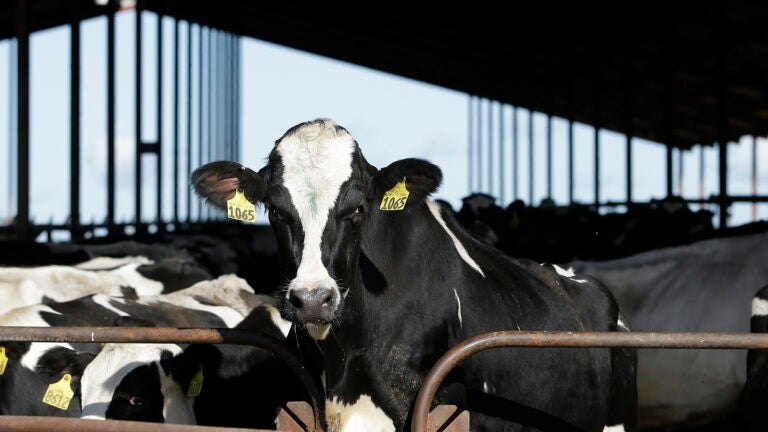Newsletter Signup
Stay up to date on all the latest news from Boston.com
After two years of not much activity, the flu could come roaring back this year.
The return of a potentially robust or even severe flu season has health experts concerned that we could finally see the arrival of a long-feared “twindemic” of COVID-19 and influenza, which would burden an already strained health care system.
But flu seasons are notoriously difficult to predict. (Despite worries, a “twindemic” never emerged in recent years.)
Still, headed into the 2022-2023 flu season, local infectious disease experts say there is cause for concern that this year could buck the trend.

While it’s difficult to predict how a flu season will shape up compared to prior years, one of the mechanisms health experts use for forecasting what could be seen in North America is by monitoring how influenza is circulating in the Southern Hemisphere.
“Sometimes that’s an accurate reflection … but it doesn’t 100 percent predict what will happen here,” Dr. Larry Madoff, medical director of the state Department of Public Health’s Bureau of Infectious Disease and Laboratory Sciences, said.
People look to countries like Australia and New Zealand to see which strains are circulating and how severe their flu season, which is typically from April to September (their winter), is.
Preliminary data indicates flu cases in 2022 peaked earlier and higher in Australia than in any of the previous five seasons, and children and teens were more likely to have been affected than adults, according to a recent article in The Journal of the American Medical Association. But even though the country saw a high number of cases, the impact was measured as “low to moderate” by the government.
The number of patients hospitalized with flu also peaked early, but not higher, than in the previous five seasons, according to the publication.
The early season and high volume of cases seen down under is being eyed by Dr. Erica Shenoy, associate chief of Massachusetts General Hospital’s Infection Control Unit, as a potential indicator for what we could see in Massachusetts and the Northern Hemisphere.
The flu trends from recent years are also a factor.
“We’ve seen very, very little flu,” she said. “And with most of society kind of back to normal activities as the cooler air sets in and people are indoors more, we would expect increases, not just in flu, but other respiratory viruses, which are circulating.”
Social distancing and other COVID pandemic measures resulted in Massachusetts seeing hardly any flu in 2020, according to Madoff.
Then in 2021, it was “unusual,” with influenza popping up early and late, but with not much in between.
“Fewer people have gotten flu in the last couple of years, and that’s always a little bit of a warning sign because when people get the flu, they develop some immunity to it,” Madoff said. “And when they don’t get the flu, there’s less immunity around, and that’s particularly true for kids who haven’t seen very many flu seasons. So that is somewhat worrisome — that this year fewer people are going to be immune to the flu and that might tend to give us a more severe flu season.”
The fact that many of the COVID-19 mitigation measures (like social distancing and mask mandates) that aided flu prevention in previous years are now relaxed also means more influenza could be seen this year.
Those factors — relaxed pandemic measures and less immunity to the flu — are likely at least partly behind the “extra severe flu season” being seen in the Southern Hemisphere, Madoff said.
“We won’t be surprised if we have more influenza in the Northern Hemisphere this year,” he said.

Madoff said it is possible that the flu season could be worse, either in severity or by the numbers, than COVID this year, given that there’s probably less immunity for influenza because of the last few years.
The state epidemiologist said the possibility of a “twindemic” is a concern and one that the state is watching closely.
“It’s something to be aware of, and it’s a really good reason people should get vaccinated for both COVID and the flu,” he said. “There’s the new bivalent booster vaccine, for which almost everyone is eligible and should get as soon as they can. And also, every year, it’s time for a flu vaccine, for everyone six months of age and older.”
The bottom line, Madoff said, is that no one wants either of the diseases to be circulating, since they both can cause severe illness and spread among close populations, like at school.
Shenoy, who noted that she was asked about the possibility of a twindemic for the last two years, said it’s hard to say whether it could emerge this year.
“Each year we have lots of people who could be vaccinated for flu, who just choose not to,” she said. “And so if we have a combination of an earlier flu season, a more robust flu season, less immunity from prior exposure the last two years, and add to that perhaps not as good vaccination as we would like, then we could certainly see a more impactful flu season.”
She pointed out that in the Northeast, there continues to be “pretty substantial levels of COVID circulating.”
“If flu comes back with a vengeance this year, then we’ll just have that on top of it and need to manage it,” Shenoy said. “And hopefully people will take the time over the next month or so and get vaccinated so that they’re protected.”
Madoff and Shenoy agreed the concern with a twindemic is that it could cause more strain on an already burdened health care system.
“Our health care system is already under a lot of stress,” Madoff said. “There are very high volumes of patients in our health care facilities already, and every flu season, even before the pandemic, the flu season always stretched capacity in our health care system. So we see this every winter that there are more people hospitalized during the flu season, so we won’t be surprised at all to see if that happens again — and that’s adding to volumes already caused by COVID.”
Preventing a swamping of the health care system is another important reason for people to get their flu vaccine and COVID booster, the doctors said.
The question of how viral interference — a phenomenon where contracting one virus reduces the risk of being infected with another — could factor into the 2022-2023 season remains to be seen.
Madoff said viral interference may have been a factor for seeing less flu during the omicron surge last year.
But while he said it can be difficult to get two viruses at the same time, it does happen.
“We are seeing some people do get co-infections with multiple viruses, and that’s particularly dangerous,” he said. “That’s something that can cause more severe disease. And so while viral interference is something our body uses to protect us from getting a second viral infection, it can still happen. You can get viral co-infections, and those infections can be more severe.”

Both Madoff and Shenoy stressed the best thing you can do to protect against the flu season — no matter how it shapes up — is to get vaccinated.
It’s important every year, but Madoff said given the increased risk of seeing a more severe season this year, it is even more essential.
He recommended rolling up both sleeves and getting your flu shot along with your COVID booster, one in each arm, at the same time.
“This is the time to get a flu vaccine,” he said last week. “Normally we really urge people to get vaccinated in October. That way their immunity is up before the flu season hits. We’re already starting to see some flu activity in southern states, which is where it typically begins. Texas, Georgia are already seeing some upticks in their influenza rates. And we won’t be at all surprised to see it come here.”
Since both flu and COVID are expected this year, and both viruses have symptoms that can’t always be distinguished, Madoff said it is important for people to stay home if they’re sick to prevent spreading the diseases.
People should also get tested if they have a respiratory infection, both for COVID-19 and the flu, he said.
Shenoy said if you do develop symptoms of the flu or COVID-19 to get in touch with your doctor about potential treatment.
“If you’re a patient who’s at high risk for severe disease, we can provide treatment, even without a flu test if you’re at high risk for complications and clinically it appears that you have flu,” she said. “So people should definitely be in touch with their physicians if they are concerned that they have the flu.”
Those who are typically most severely affected by the flu are people over the age of 65, pregnant women, and young children, particularly under the age of 6. Children under the age of 2 are at even more risk for severe complications from the flu.
Shenoy urged parents to get started on getting their littles vaccinated, particularly if it’s their first season, since they will need multiple shots.
“You want to get started on that as soon as you can,” she said. “I know some pediatrician offices don’t have it yet, but you should be checking in to see if it’s available to get started on getting vaccinated.”
Madoff said this year, for the first time, the Centers for Disease Control is also recommending people over the age of 65 to get either the high dose or adjuvanted flu vaccine, which induce more of an immune response and offer better protection for the most vulnerable populations.
“Really everyone should get a flu shot,” Madoff said. “And the reason is not just to protect yourself, but to protect people around you. So if you don’t get the flu, you won’t give it to your elderly parent or grandparent or your immunocompromised neighbor.”
The state epidemiologist noted that Massachusetts has a trend of doing well with vaccination rates, both for COVID and for the flu.
“We want everybody to keep up the good work,” he said.
Stay up to date on all the latest news from Boston.com

Stay up to date with everything Boston. Receive the latest news and breaking updates, straight from our newsroom to your inbox.
Conversation
This discussion has ended. Please join elsewhere on Boston.com